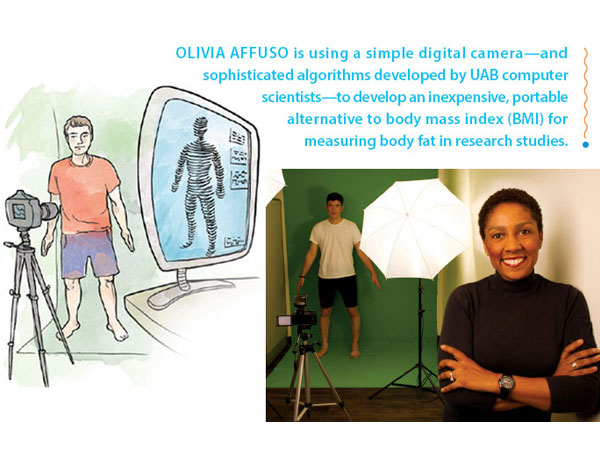Photobody Study Examines High-Tech Replacement for BMI
The old saying in Hollywood is that the camera adds 10 pounds. But UAB obesity researcher Olivia Affuso, Ph.D., thinks that the right software could transform even a basic digital camera into a very accurate judge of body fatness.
Her study, appropriately named Photobody, is funded by the National Institutes of Health. The country’s research heavyweight is seeking an inexpensive, portable, and simple way to measure body fat in large-scale epidemiological research studies. Affuso, along with co-investigators David Allison, Ph.D., and Chengcui Zhang, Ph.D., is developing just such a solution.
 Body fat is a crucial measure of a patient’s health or the effectiveness of treatment. Most studies use body mass index (BMI) as a proxy for body fat because it has several advantages. For one, it’s a fairly simple calculation that only requires two inputs: a participant’s weight and height. Research also shows that BMI is a good gauge of a person’s risk for everything from heart disease to breathing issues and some cancers. But “BMI has its limitations,” Affuso explains. “If you are very muscular, you can fall into the overweight category even if you are normal weight. Or it can underestimate body fat in people who are normal weight but have low muscle mass.”
Body fat is a crucial measure of a patient’s health or the effectiveness of treatment. Most studies use body mass index (BMI) as a proxy for body fat because it has several advantages. For one, it’s a fairly simple calculation that only requires two inputs: a participant’s weight and height. Research also shows that BMI is a good gauge of a person’s risk for everything from heart disease to breathing issues and some cancers. But “BMI has its limitations,” Affuso explains. “If you are very muscular, you can fall into the overweight category even if you are normal weight. Or it can underestimate body fat in people who are normal weight but have low muscle mass.”
To get more accurate readings, investigators at UAB and elsewhere turn to DXA (pronounced DEXA) scanners. “The problem is that a DXA scanner is well over $100,000, so not many places outside of major universities actually have one and it is not portable without a truck,” Affuso says.
But trained body composition assessors are often able to guess a person’s body fat with a high level of accuracy just by looking at them, Affuso explains. That gave the UAB researchers an idea. “We’re using techniques with foundations in photogrammetry, as well as some topography, to train a computer to recognize body fat,” says Affuso. In her lab/photo studio at the UAB School of Public Health, Affuso’s team takes three pictures of volunteers aged 6 to 80. Advanced computer algorithms designed by Zhang then analyze the photos and spit out an assessment of the person’s body fat percentage and compares that information to the DXA. The system is now covered by a patent.
The goal is to “come up with an easy, portable, inexpensive, easily replicated way to assess body composition,” Affuso says. Researchers could take the system into the field to do long-term evaluations of body fat for an obesity intervention at a school, for example, “instead of bringing all the participants in here, as we have to do now.”
The technology also has clinical applications, Affuso adds. “This would be a great way for physicians to help their patients look at weight change over time.”